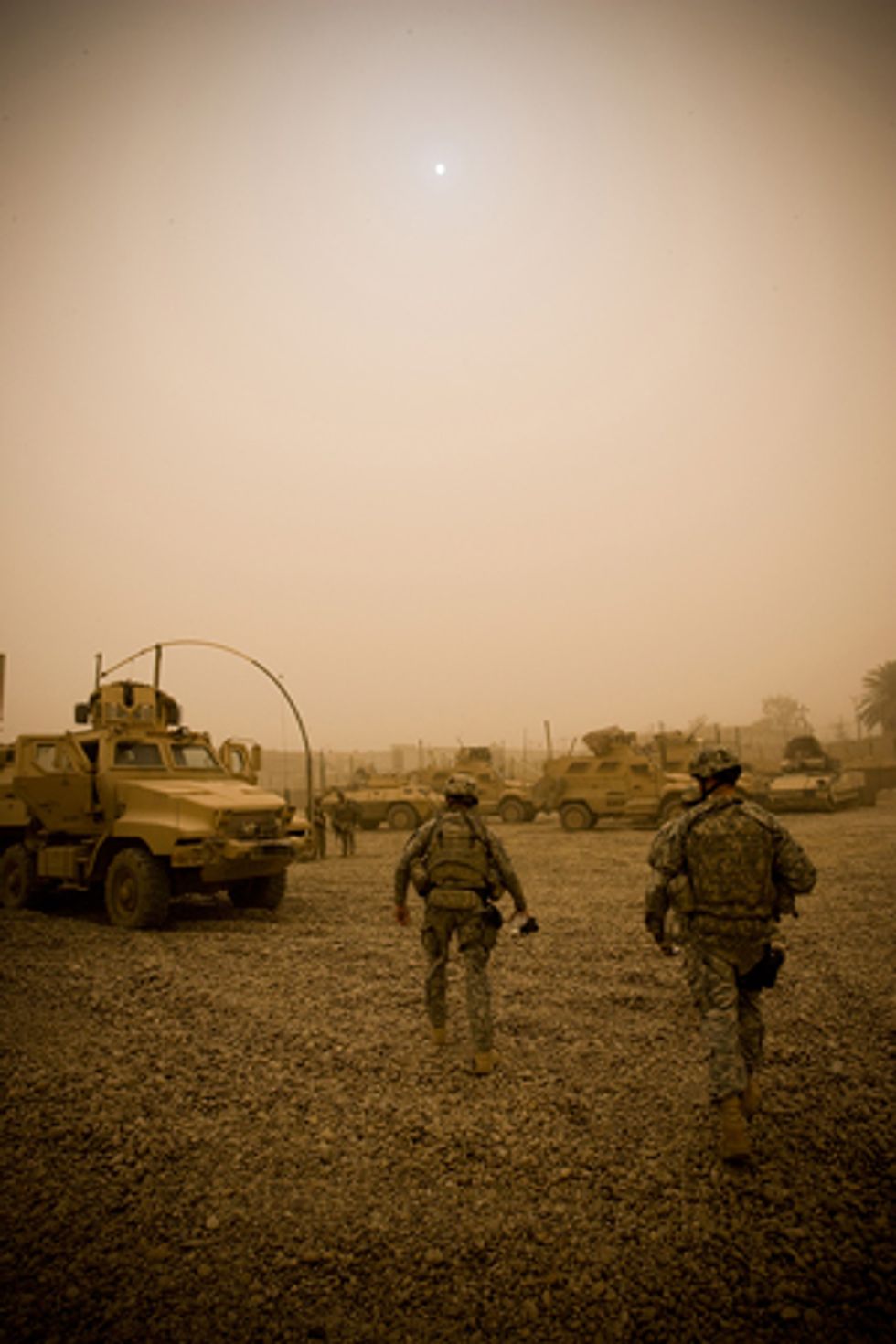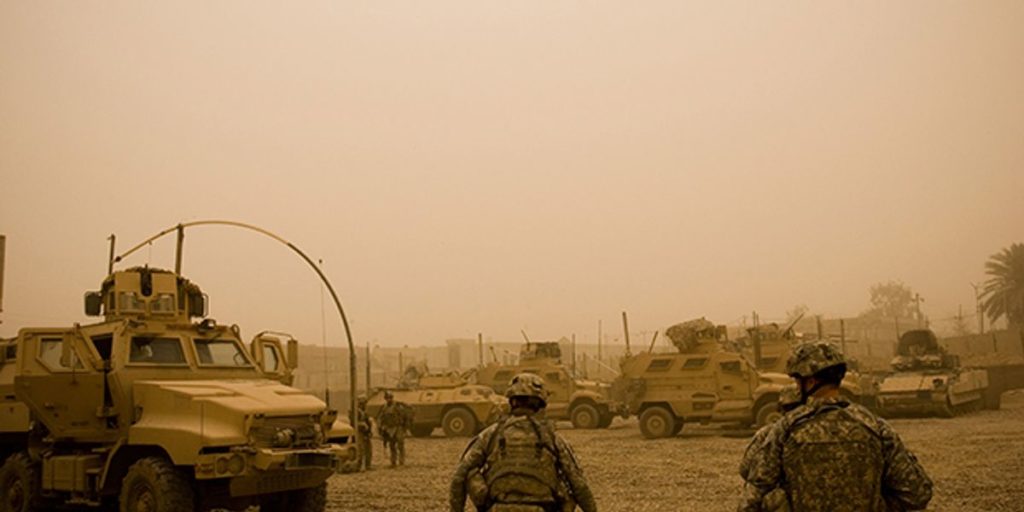Part one of a two-part report

Photo: Zoriah
Two platoons of U.S. Army scouts are in a field deep in the notorious “Triangle of Death” south of Baghdad, a region of countless clashes between Sunni insurgents and Shia militias. The platoons are guided by a local man who’s warned them of pressure-plate improvised explosive devices, designed to explode when stepped on. He has assured them that he knows where the IEDs are, which means he’s almost certainly a former Sunni insurgent.
The platoons come under harassing fire. It stops, but later the tension mounts again as they maneuver near an abandoned house known to shelter al-Qaeda fighters. A shot rings out; the scouts take cover. They don’t realize it’s just their local guide, with an itchy trigger finger, taking a potshot at the house. The lieutenant leading the patrol summons three riflemen to cover the abandoned house.
Then all hell breaks loose. One of the riflemen, a sergeant, steps on a pressure-plate IED. The blast badly injures him, the two other riflemen, and the lieutenant. A Navy explosives specialist along on the mission immediately springs into action, using classified gear to comb the area for more bombs. Until he gives the all clear, no one can move, not even to tend the bleeding men. Meanwhile, one of the frozen-in-place scouts notices another IED right next to him and gives a shout, provoking more combing in his area. Then a big area has to be cleared so that the medevac helicopter already on the way can land. The sergeant dies several hours later in a field hospital.
That incident, which took place on 7 November 2007, exhibits many of the hallmarks of the missions in Iraq and Afghanistan—a small patrol; a local man of dubious background; Navy specialists working with soldiers on dry land; and costly technologies pressed into service against cheap and crude weapons.
And, most of all, death by IED.
“Sergeant T” became one of the 24 coalition soldiers killed by IEDs that month in Iraq. As of the end of June, IEDs have killed untold thousands of Iraqis and Afghanis, as well as 1795 coalition military people in Iraq and another 231 in Afghanistan, according to the Web site iCasualties.org. Those figures are nearly half of all combat fatalities in Iraq and roughly 30 percent of those in Afghanistan, according to the site.
IED fatalities in Iraq were down sharply in May and June, to 14 and 11, according to iCasualties. But they were up in Afghanistan, to 12 in May and 22 in June. Overall, in the first half of this year, IEDs, including suicide bombs, killed 115 coalition people in Iraq and 72 in Afghanistan. Those figures mean that in the first half of 2008, IEDs caused 54 percent of all coalition deaths (including nonhostile ones) in Iraq and 59 percent in Afghanistan.
The U.S. military has responded with the most intensive program of technology development in at least a decade. It has spent US $12.4 billion over the past three years on counter-IED equipment, technology R&D, training, and other measures through the Joint Improvised Explosive Device Defeat Organization and its predecessors.
JIEDDO says that its mission is to support efforts to defeat IEDs as “weapons of strategic influence.” This wording acknowledges that insurgent fighters use IEDs with no hope of defeating a military force in the traditional sense. The point is to cause death and destruction resulting in news imagery that affects the political will of the country that dispatched the force. This distinction is significant because it implicitly suggests that IEDs and the casualties they cause cannot be eliminated. It points to a response based on minimizing their effectiveness, for example with armor and by other means, to marginalize their strategic impact.
JIEDDO emphasizes a holistic approach, incorporating such nontechnical aspects as training troops in counter-IED tactics and technology and using law enforcement techniques, forensics, and intelligence to smash the networks that build and deploy IEDs. But this year, $2.57 billion of JIEDDO’s $4.38 billion budget is devoted to developing counter-IED technologies, feeding a perception that the agency is chasing a cure-all.
![]()
Editor’s note: To minimize the possibility that information in this article could endanger coalition personnel in Iraq or Afghanistan, a draft of this article was reviewed by current and former officials of the Joint IED Defeat Organization, a U.S. Department of Defense agency. In response to those reviews, IEEE Spectrum voluntarily removed three passages and the names of two active-duty U.S. military personnel.
![]()
In an interview, a civilian at a military academic institution who studies counter-IED tactics characterized the U.S. approach as “hide and pray: hiding behind more armor and praying that there’s a technical solution to all this.”
Three U.S. military officers offered more specific criticisms in a recent paper for the Joint Forces Staff College, in Norfolk, Va. JIEDDO, they wrote, “is still built around a technical-solution approach focused on research and development, testing, and fielding the elusive ‘silver bullet’ to defeat IEDs.”
There are lots more published criticisms in that vein. Nevertheless, it’s basically impossible to find anyone inside or outside of JIEDDO who believes in a “silver bullet” technology that will solve the IED problem. On the other hand, it’s not too hard to find people who think that technologies—including ones that predict or detect IEDs as well as others that neutralize them or at least lessen their effects—will be part of a complicated and variable set of responses that reduce the lethality of IEDs and also increase their costs to the extent that they become ineffective.
The challenge is more complex than most people realize. “There have been no easy problems when it comes to measure-countermeasure, whether you’re talking about submarine warfare–antisubmarine warfare, tank-antitank, or antiaircraft-counterantiaircraft,” says Daniel Gouré, vice president of the Lexington Institute, an Arlington, Va., think tank. “They’re always immensely complicated challenges in which technology just plays a piece.
“Overall,” Gouré adds, “the effort to counter the IED has been a real lesson in humility to a military that has always prided itself on being able to find a technical solution to a problem.”
The U.S. experiences in Iraq and Afghanistan have pretty much confirmed that technology alone can’t solve an IED problem. U.S. forces did not see steep declines in IED incidents in parts of Iraq until they gained the cooperation of local people in those areas and secured their help in aggressive efforts to attack the terrorist networks that put IEDs on the roads.
The problem is that in war or its aftermath, the active support of local people can seldom be counted on. And IEDs are already a problem in places where there is no occupation, where no war is being fought, and where there is no antagonistic local population to be won over.
It’s not easy to assess counter-IED technology’s capabilities and limits, because researchers are pursuing hundreds of projects, many of them are classified, and some have yet to prove themselves outside of a laboratory. Nevertheless, with the United States and other countries pouring billions of dollars into counter-IED activities, a couple of questions come to mind: how much can technology do, in the absence of local cooperation, to reduce casualties from IEDs? Can some combination of the technologies now being pursued, together with nontechnical approaches such as intelligence exploitation, suffice to marginalize the strategic influence of IEDs?
The alternative scenario is not pretty. In it, the IED continues for the foreseeable future to be the weapon of choice for the world’s terrorists, insurgents, militias, guerillas, revolutionaries, and marginal or failed states.
The stakes are high. The scale and urgency of the struggle to devise an effective response reflects not just the deaths in Iraq and Afghanistan but also an almost universal consensus among military analysts and government officials that the IED problem will long outlive those conflicts. Lots of facts support that view, but start with this one: outside of Iraq and Afghanistan, there are 200 to 350 IED attacks every month around the world, according to the Triton report, which is published periodically by the British counter-IED consulting firm Hazard Management Solutions. IED attacks are particularly common in Colombia, India, Indonesia, Pakistan, the Philippines, Russia (Chechnya), and Sri Lanka.
In Pakistan alone, IEDs, including suicide bombs, killed 865 security people and officials last year, according to testimony in the U.S. Senate in February. In 2006, British officials dealt with 250 IEDs in the UK, according to Andy Trotter, deputy chief constable of the British Transport Police. They were planted by “criminals, animal rights activists, disturbed individuals, and terrorists,” Trotter says.
IEDs aren’t new. In World War II, Belorussian guerillas used them against the German army. The Vietcong made them out of unexploded U.S. ordnance during the Vietnam War. The mujahideen used IEDs in Afghanistan in the 1980s against the Soviets.


